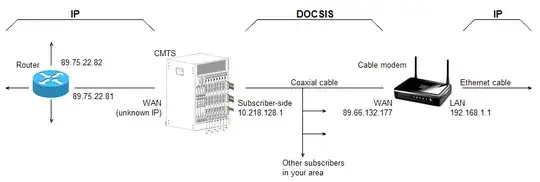Here is a log of tracert superuser.com from my computer:
Tracing route to superuser.com [198.252.206.16] over a maximum of 30 hops: 1 2 ms 2 ms 2 ms 192.168.1.1 2 11 ms 17 ms 9 ms 10.216.128.1 3 12 ms 17 ms 14 ms 89-75-22-81.infra.chello.pl [89.75.22.81] 4 23 ms 17 ms 17 ms 84.116.192.102 5 18 ms 18 ms 15 ms pl-krk01a-rd4-ae0-2183.aorta.net [84.116.253.70] 6 20 ms 16 ms 15 ms pl-waw04a-rd1-ae12-2158.aorta.net [84.116.252.225] 7 15 ms 15 ms 15 ms 84.116.135.225 8 17 ms 19 ms 24 ms henet.plix.pl [195.182.218.197] 9 34 ms 44 ms 49 ms 10ge1-2.core1.prg1.he.net [184.105.213.241] 10 33 ms 44 ms 34 ms 10ge15-3.core1.fra1.he.net [184.105.213.233] 11 45 ms 51 ms 48 ms 100ge5-2.core1.par2.he.net [72.52.92.13] 12 161 ms 163 ms 156 ms 10ge15-1.core1.ash1.he.net [184.105.213.93] 13 131 ms 124 ms 124 ms 100ge7-1.core1.nyc4.he.net [184.105.223.166] 14 121 ms 121 ms 121 ms 10ge4-1.core1.nyc5.he.net [184.105.213.218] 15 122 ms 120 ms 121 ms lightower-fiber-networks.10gigabitethernet3-2.core1.nyc5.he.net [216.66.50.106] 16 122 ms 123 ms 121 ms ae12.nycmnyzrj91.lightower.net [64.72.64.110] 17 122 ms 120 ms 122 ms ae2-jrcynj67j41.lightower.net [72.22.160.175] 18 123 ms 123 ms 122 ms 69.46.229.98.lightower.net [69.46.229.98] 19 124 ms 123 ms 123 ms stackoverflow.com [198.252.206.16] Trace complete.
The first entry (192.168.1.1) is my router, which does not surprise me. What is weird is the second entry, 10.216.128.1, which shows even when doing the traceroute from my router or when the computer is directly connected to the internet. My router has a public IP — is my ISP violating the IP standard? Would such configuration prevent me from using the 10.216.128.x range in my own network?
There is a diagram in an answer to a related question which does not really answer mine — my router knows nothing of the 10.216.128.x network, and the hop shows even when tracerting another hosts on its subnet, which the router should theoretically be able to contact directly:
Tracing route to 89-66-132-2.dynamic.chello.pl [89.66.132.2] over a maximum of 30 hops: 1 2 ms 2 ms 2 ms 192.168.1.1 2 27 ms 11 ms 10 ms 10.216.128.1 3 18 ms 21 ms 18 ms 89-66-132-2.dynamic.chello.pl [89.66.132.2] Trace complete.
What is funny is that this private IP does not show up when tracerting the gateway:
Tracing route to 89-66-132-1.dynamic.chello.pl [89.66.132.1] over a maximum of 30 hops: 1 3 ms 2 ms 2 ms 192.168.1.1 2 10 ms 11 ms 11 ms 89-66-132-1.dynamic.chello.pl [89.66.132.1] Trace complete.
while tracerting an address which is not even in the same network it shows up again, while the gateway seemingly disappears:
Tracing route to 89-69-109-1.dynamic.chello.pl [89.69.109.1] over a maximum of 30 hops: 1 2 ms 2 ms 2 ms 192.168.1.1 2 12 ms 14 ms 12 ms 10.216.128.1 3 16 ms 15 ms 21 ms 89-69-109-1.dynamic.chello.pl [89.69.109.1] Trace complete.

